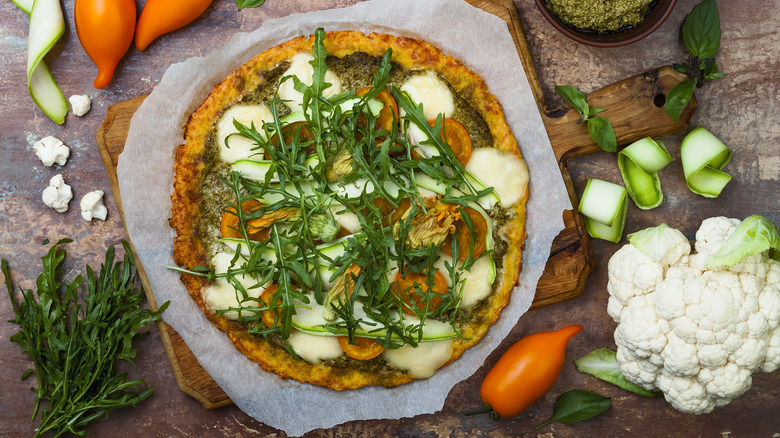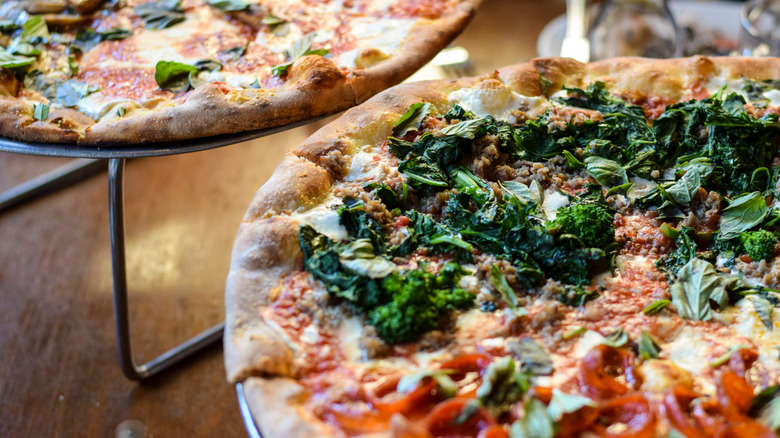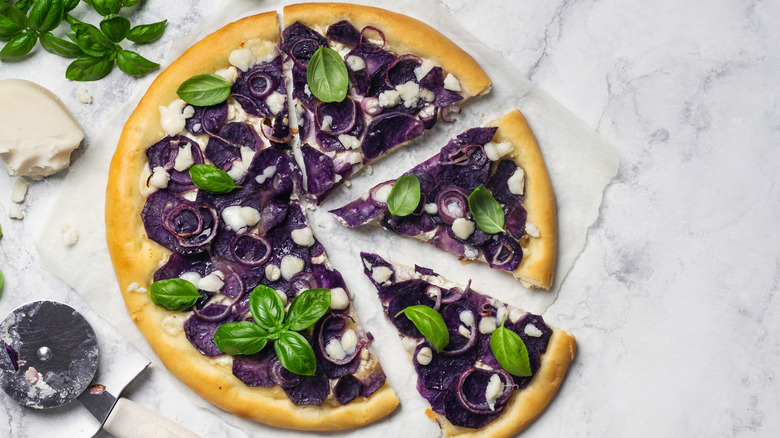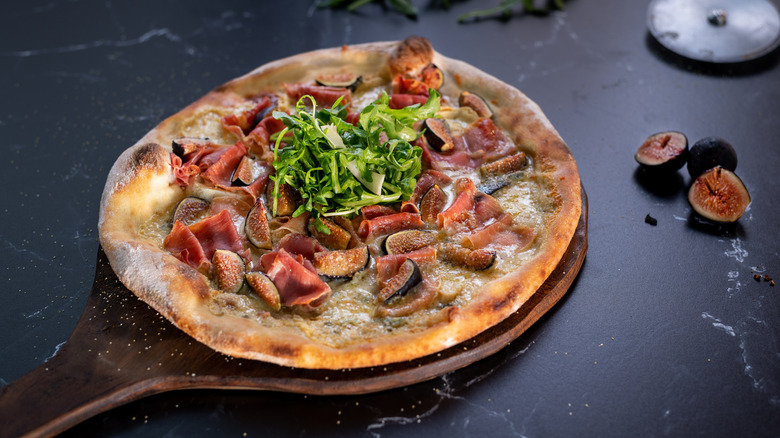15 Underrated Pizza Toppings You Should Add To Your Pie
Are you stuck in a pizza topping rut? There's nothing wrong with sticking to the tried-and-true, but let's face it — they can become rather boring. If you're looking for some topping inspiration, we have some expert tips that can help you level up your pizza game. We spoke to two of California's most celebrated pizzaiolos and asked them to share some of their favorite underrated pizza toppings that they think deserve more attention.
Tony Gemignani is a 13-time World Pizza Champion and owner of Tony's Pizza Napoletana in San Francisco. He's renowned for his diverse pizza styles including traditional Neapolitan and modern creations. Francesco Zimone is the visionary who brought L'Antica Pizzeria Da Michele from Naples, Italy to Los Angeles. He's famed for his Neapolitan pies that fuse traditional techniques with innovative twists.
If you want to experiment with new toppings, consider trying some of these underrated ingredients. And if you happen to be in California this month, be sure to check out the Golden State Pizza Takeover where Gemignani and Zimone will take over each other's kitchens. You can catch Zimone at Tony's Pizza in North Beach on December 10th and Gemignani at L'Antica Pizzeria Da Michele's Hollywood on December 17th.
1. 'Nduja
Looking to level up the spice factor of your pizza? 'Nduja is a fiery red sausage that comes from the Calabria region of Italy. It gets its vibrant color and spiciness from Calabrian chiles. The ground chiles are mixed with herbs, spices, and fatty ground pork, then stuffed into a casing and left in a warm space to ferment. Sometimes the 'nduja is also smoked. After the fermentation, the sausage is cured for several months. The result is a spicy, tangy, soft sausage.
Tony Gemignani believes 'nduja is a pizza topping that doesn't get the love it deserves. For one, it's a soft sausage, so it's very spreadable. The bold, fiery flavor adds spice and goes well with mild cheeses like mozzarella and sweet elements like roasted red peppers. You can mix it into your tomato sauce or add it directly to the pizza. However, Gemignani recommends adding the 'nduja at the end. He said, "People tend to put 'ndjua on before they bake, but it's actually an ingredient you should put on post-bake. With just a little residual heat, the 'ndjua is just right."
2. Broccoli rabe
When we asked the chefs if there were any underrated vegetarian toppings they recommended for adding bold flavors, both mentioned broccoli rabe. Also called rapini, broccoli rabe has buds that look similar to regular broccoli florets. However, that's where the similarities end. This cruciferous vegetable is actually more closely related to turnips than broccoli. It has long stems and plenty of large dark leaves. In addition, broccoli rabe has a very bitter taste.
Francesco Zimone said, "Broccoli rabe adds a peppery flavor and slight bitterness to pizza." If you want to tone down some of the bitterness, you can roast or blanch the broccoli rabe before adding it to your pizza. Zimone recommends pairing it with sausage. The sharpness of the rapini can cut through the fattiness of the pork and add earthy, nutty flavors. You may also want to balance the bitterness with something sweet like cherry tomatoes or hot honey. A mild cheese like ricotta or burrata can also temper some of broccoli rabe's bite.
3. Carnitas
Carnitas is an iconic Mexican dish, so most people don't equate it with Italian cuisine. However, Tony Gemignani says that carnitas can work surprisingly well on pizza. Carnitas is made by braising or simmering pork shoulder with herbs, spices, citrus juice, and sometimes lard. It's slow-cooked for hours until the pork is ultra-tender and shreddable. The final step is roasting the shredded pork so that it gets slightly crispy on the edges. It's a great ingredient to use if you want to create a Mexican-style pizza.
When we asked Gemignani for suggestions on how to make a killer carnitas pizza, he said, "Make it a white pie — meaning without tomato sauce — then add other ingredients like mozzarella, Jack, corn, a squeeze of lime, and sliced Serrano peppers." You can also take inspiration from carnitas tacos and add garnishes like chopped onions, cilantro, and pico de gallo. A creamy cilantro-lime sauce or avocado-jalapeño sauce can also brighten up your pie and add extra freshness.
4. Peppadew peppers
Customers often ask Tony Gemignani for pizza toppings that are different from the norm, and one that he often recommends is Peppadew peppers. These vibrant peppers are more sweet and tangy than they are spicy, although they do have a mild heat to them. Peppadew is actually the brand name of the South African company that sells these jarred peppers. The peppers are piquanté peppers that are pickled in brine. You may be able to find jars of Peppadew peppers in your local grocery store or specialty shops.
Peppadew peppers work well on pizza because they add color, texture, and vibrant flavors. The brining process helps preserve the color and crunch of the peppers and adds acidity to their fruitiness and spice. The peppers pair well with a wide variety of pizza toppings. For example, Gemignani has a pizza on his menu at Tony's Pizza Napoletana called Grandma The Butcher that combines sweet tomato sauce, mozzarella, garlic, oregano, pecorino, basil, pepperoni, salami, Italian sausage, smoked applewood bacon, hot coppa, arugula, and peppadews.
5. Purple potatoes
Another interesting pizza topping that Tony Gemignani suggests for customers who want something unique is purple potatoes. These colored tubers are native to the Andes mountain region of South America (as are all potatoes) and they come in a variety of colors, from dark purple to violet and blue. The flesh inside is also colored and sometimes marbled. There are several varieties of purple potatoes, most of which are quite small compared to other potatoes, and are either round or oblong.
Purple potatoes taste similar to other potatoes like fingerlings and russets. You can use them just like you would any potatoes on pizza. A classic Italian potato pizza includes thinly sliced potatoes, olive oil, and rosemary. As the potatoes cook, they soften and develop a creamy texture that negates the need for cheese. Of course, we wouldn't blame you if you wanted to add cheese as well. You could also add bacon or prosciutto for extra saltiness or fresh basil for greenery to contrast with the purple hue of the potatoes.
6. Hazelnuts
Hazelnuts are versatile nuts that typically make appearances in chocolates and baked goods like cakes and cookies. However, they can also be a tasty addition to pizza. Francesco Zimone suggests using them on a dessert pizza. He told us his preferred combo is, "Chocolate, strawberries, banana, and hazelnut; a simple but sensational dessert — no marinara obvi!" This sweet and crunchy pizza makes for a great after-dinner treat or a sweet breakfast pizza for brunch.
Hazelnuts have a rich buttery flavor that pairs well with fruits and chocolate. Plus, the nuts add a nice crunch to the otherwise soft ingredients that you typically find on dessert pizzas. You can chop up the nuts and add them to the pizza raw, although roasting will enhance the rich flavor and add a touch of sweetness. Whether they're raw or roasted, there is one step you should take before baking with hazelnuts. The skin of the nuts can be quite bitter, so you'll want to peel it off. The easiest way to get the skins off hazelnuts is to roast or blanch the nuts first, then rub away the skin.
7. Figs
If you want to add a pop of color and some interesting flavors to your pizza, consider adding figs. Francesco Zimone said, "They are an explosion of sweet and savory and can be paired with so many bold flavors to make [the pizza] vegan, meaty, or ultra-cheesy." The jammy interior adds a soft texture, while the seeds give a pleasant crunch.
Figs are one of the oldest cultivated fruits on the planet. They're unique in that the flowers of the fig tree grow inside the plant's green or purple pods. The flowers turn into fruits with singular seeds, and each fig pod contains multiple fruits. All parts of the fig pod are edible including the fruit, seeds, and skin. Fresh figs are best, but you can also buy them dried or preserved.
As Zimone said, figs work well with a wide array of ingredients. Popular pairings include prosciutto, goat cheese, arugula, and caramelized onions. The key to a great fig pizza is balancing the sweetness of the fruit with other flavors like salty, umami, and bitter. Spicy ingredients like pepperoni or soppressata picante also work well.
8. Squash blossoms
Peruse the menu at Tony's Pizza Napoletana and you'll find tons of unique pizza toppings that don't often make an appearance on classic American pizzas. One that Tony Gemignani is a fan of is squash blossoms. He said he often recommends it to customers who are looking for something unconventional, but also tasty. The bright colors of the blossoms add visual appeal, while the texture and taste are delicate and subtle.
Squash blossoms can come from any type of squash plant including zucchini, pumpkin, and crookneck squash. The flowers are typically yellow or orange and have long, thin petals. You may have seen squash blossoms or zucchini flowers offered as an appetizer at Italian restaurants. They're often fried and can be stuffed with ingredients like ricotta cheese, herbs, and tomatoes. They're a nice touch on pizza because the flavor is mild with floral and squash undertones, which melds well with other ingredients. You can add whole or sliced blossoms to your pie.
9. Corn
Many people might balk at adding corn to pizza, but some chefs believe that it's a seriously underrated pizza topping. You get nice pops of color from the yellow kernels and the texture is both crisp and juicy. The distinctive flavor of corn can also provide a nice contrast to other ingredients. Francesco Zimone said he found that it works surprisingly well with prosciutto. He said, "The corn adds a subtle sweetness." Other ingredients it pairs well with include mild and tangy cheeses, spicy sausages like chorizo, and fresh herbs.
The other great thing about corn is that there are so many varieties you can use, as well as multiple ways you can prepare it before adding it to your pie. You can opt for sweet corn, heirloom blue corn, or white corn. Canned corn will work, although many chefs say fresh corn is key. If you're using fresh corn, you can boil it first or fire it up on the grill to give it a smoky flavor. You can sprinkle the kernels over your pie or use whole corn ribs for extra visual appeal and bite.
10. Tuna
Tuna can be a pretty divisive pizza topping, especially for those who didn't grow up eating seafood on pizza. As Tony Gemignani said, "It's a popular topping in Italy, so European customers understood and appreciated that pizza, but it took some explaining for our American customers." You might think that the tuna would overpower the pie with fishy flavors, but pair it with the right ingredients and you'll find that's not the case.
Any type of canned tuna will do the trick, although some chefs recommend tuna canned in olive oil because it adds extra richness to the pizza. Francesco Zimone recommends jarred tuna in olive oil. Tonno e cipolla is a classic Italian pizza that features tuna with tomato sauce, mozzarella cheese, red onions, and olives. You could also take inspiration from Japanese sashimi and top your pie with thinly sliced ahi tuna after it comes out of the oven. Once you've tried tuna, you may be inspired to branch out and try different seafood toppings like clams or smoked salmon on your pizza.
11. Calabrian chiles
One spicy ingredient that both chefs agree is stellar for adding a hit of heat to your pie is Calabrian chiles. Also called Calabrese peppers, these small red chiles come from the Calabria region of Italy and they're a staple in Southern Italian cuisine. The flavor is fruity and spicy with a medium level of heat. They'll definitely add some spice to your pizza, but unless you're especially susceptible to spicy foods, they probably won't set your mouth on fire. Outside of Italy, they're typically sold jarred in olive oil. You also might be able to find Calabrian chile flakes and ground Calabrian chile powder.
If you love hot sauce or hot peppers on pizza, there's a good chance you'll love Calabrian chiles as well. You can slice them and add them directly to your pie or use them in your sauce. Tony Gemignani said, "Calabrian peppers cooked into a vodka cream sauce is nice." The fruity, picante flavor pairs well with a wide array of ingredients. For example, Franceso Zimone's Caserta pizza At L'Antica Pizzeria Da Michele combines fior di latte, rapini, Italian sausage, smoked provolone, and Calabrian chiles.
12. Spam
Love it or hate it, there's no disputing that Spam is an incredibly versatile ingredient. This canned luncheon meat first hit the market in 1937 and was marketed as a budget-friendly meat product that could be used in a variety of dishes. During World War II, Allied soldiers were given Spam as rations, and that spread it around the world. Since its inception, Spam has been used in everything from breakfast dishes to sandwiches, soups, and fried rice. Many say it's also a pretty tasty pizza topping.
Spam has a salty, savory taste that can work well on pizza instead of other meats like bacon or ham. You can cut it into chunks or slice your Spam into thin strips and pair it with a wide array of veggies and cheeses. Some people pair Spam with pineapple to give their pizzas a Hawaiian twist. Tony Gemignani told us about a pie he created on the television show "Bar Rescue" after the directors asked him to make a post-apocalyptic pizza using Spam. He said, "I soaked it in pineapple syrup and cut slices into long triangular pieces. Surprisingly, it was a really good pizza."
13. Fried kale
Kale skyrocketed in popularity in the United States during the early 2000s, but it's long been a common ingredient in Tuscan cooking. Visit Tuscany and you'll find kale in dishes like soups, polenta, and salads. This cruciferous leafy green also works incredibly well on pizzas. Some might say even better than other greens. For example, while spinach wilts up quickly and can release a lot of water, kale holds its shape and crisps up well.
Kale is often relegated to vegetarian or vegan pizzas, but it can also be a key ingredient in a decadent meat-forward pie. The slight bitterness of the kale can help cut through the fattiness of rich cheeses and meats. Tony Gemignani makes an interesting pizza with kale that's ultra-moreish. He fries his kale first to make it crispy and then combines it with Muenster cheese, Calabrese peppers, honey, applewood smoked bacon, and lemon. "I call it the Eddie Munster," he said.
14. Soppressata picante
Cured meats make for stellar pizza toppings. In the States, pepperoni and sausage are the most popular cured meat toppings. However, if you want something that's authentically Italian, Tony Gemignani recommends soppressata picante. He said, "Soppressata picante is the pepperoni of Italy." It's spicy, salty, and fatty and gives a similar bite to traditional American pepperoni. There are some significant differences between the two though.
Soppressata picante is a type of spicy cured salami from Southern Italy. It consists of pork, lard, and spices including chili powder. Some people also add wine. The mixture is stuffed into casings, tied with a cord or netting, and hung to cure for at least 45 days. When you cut into the meat, it's typically a beautiful red color with nice marbling from the fat. Many pizzaiolos prefer soppressata picante over pepperoni because it tends to be spicier, and the larger size and flatter shape give you bigger slices. It also contains a good amount of lard, which renders out and makes the meat moist, whereas pepperoni can often be quite dry.
15. Mortadella
When it comes to cured meats, Francesco Zimone recommends mortadella as an alternative to standards like pepperoni and prosciutto. This pale pink cold cut with white patches comes from Bologna in the Emilia-Romagna region of Italy. It's made with cubes of pork and pork fat seasoned with spices like black pepper. It often has pistachios dotted throughout as well. The pork fat gives the meat a lovely silky texture and rich taste. Mortadella is similar to bologna but the fat is in pockets instead of uniformly blended into the meat. In addition, bologna can be made with a mixture of meats, while mortadella is only pork.
Mortadella can be eaten on its own or in sandwiches like the popular muffuletta from New Orleans. It's also delicious on pizza, as it adds richness and hints of spice. Zimone offered a helpful tip for getting the most flavor from your mortadella pizza. He said, "You only want it to be warmed, not cooked." When mortadella cooks, some of the flavors tend to mellow. To preserve the taste of this luscious meat, try adding your mortadella to your pie after it comes out of the oven and let the heat from the pizza warm it up.















